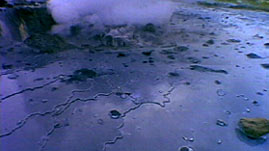Teachers' Domain - Digital Media for the Classroom and Professional Development
User: Preview

Source: Interactive NOVA: "Earth"
As this video segment adapted from Interactive NOVA states, Earth's atmosphere wasn't always predominantly composed of nitrogen and oxygen. In fact, the earliest discovered life form, single-celled bacteria, would not have survived in an oxygen-rich environment. Today, we can examine certain organisms that thrive in extreme environments without oxygen. Understanding the conditions in which life can exist -- even if these conditions are different from those in which we live -- can be valuable, especially when trying to understand Earth's first life forms.
The rock record, along with the fossil evidence and sediment it contains, holds many clues about the environmental conditions under which the earliest life forms evolved. For example, we now know that oxygen production began in the oceans at least 2.5 billion years ago and reached present-day levels in the atmosphere just 400 million years ago.
Interestingly, oxygen was toxic to the Earth's earliest organisms, which had evolved to survive in oxygen-free environments. As oxygen accumulated in the atmosphere, these anaerobes sought shelter in locations where oxygen did not exist. Today, anaerobic organisms can still be found, but only in extreme environments such as undersea vents and geothermal formations, under conditions that would be deadly to most other life forms.
Stromatolites, mounded colonies of aquatic cyanobacteria, provide the earliest fossil evidence of cellular life, approximately 3.5 billion years old. Because modern cyanobacteria generate oxygen through photosynthesis, it is believed that stromatolites may have played a significant role in creating our modern atmosphere.
Iron ore deposits also provide information on the history of oxygen on Earth. The trillions of tons of iron ore on Earth tell us that ancient oceans contained a large supply of iron. Dissolved iron falls out of solution when it encounters oxygen, and the bright-orange products of this chemical reaction -- rust particles -- settle on the ocean floor. Rust-colored sedimentary layers originally deposited on the ocean floor provide strong geological evidence that oxygen was being produced in the oceans at least 2.5 billion years ago.
As stromatolite colonies multiplied, dissolved oxygen in the ocean eventually combined with all the available iron supply in the oceans, and free oxygen began to bubble out of the ocean and collect in the atmosphere. The presence of atmospheric oxygen is indicated by distinctive rock layers about 2 billion years old, from a time when most of the planet's exposed surface actually oxidized and rusted.
A third line of evidence of the development of atmospheric oxygen is the emergence of terrestrial life. Terrestrial life requires a protective layer of ozone in the atmosphere to shield it from ultraviolet radiation. Scientists believe that the appearance of land plants, for which we have evidence 480 million years old, indicates that there was sufficient atmospheric oxygen at that time to create a protective ozone layer.
To learn more about bacteria that live in extreme conditions and may provide clues to the beginning of life on Earth, check out Deep Sea Vents and Life's Origins.
To learn about the similarities cave-dwelling microbes share with Earth's earliest living things, and how they may influence the debate about whether life can exist elsewhere in the universe, check out Caves: Extreme Conditions for Life.
 Loading Standards
Loading Standards Teachers' Domain is proud to be a Pathways portal to the National Science Digital Library.
Teachers' Domain is proud to be a Pathways portal to the National Science Digital Library.
